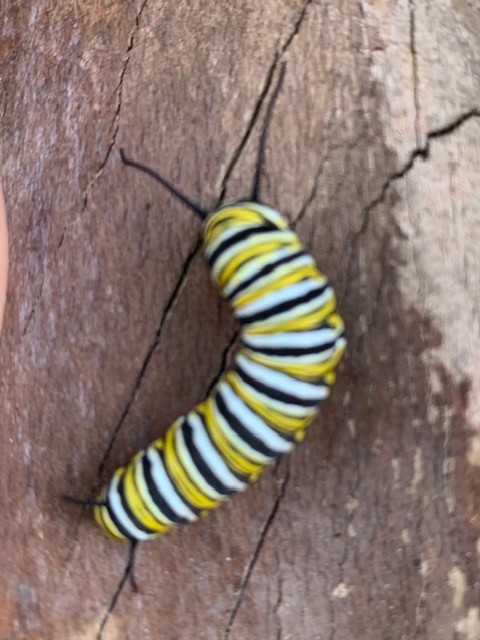My family gathered in Florida for the holidays to enjoy the balmy weather. Our dogs tumbled all over each other as we walked together down the sidewalk between a busy residential street and the Indian River on the East coast of Florida.
We found a fat caterpillar with yellow, black and white stripes trying to cross the road, so my grandson picked it up on a piece of palm bark (you can see it in the picture below). It was probably crossing the road to find a place to build a chrysalis and pupate. We wondered where it had been eating, because it looked like a Monarch caterpillar (Danaus plexippus) and we couldn’t find any milkweed nearby. Monarchs are fussy eaters and will eat only milkweed. We found only mangroves and white Biden nearby.
When caterpillars are ready to build a chrysalis they should be in their last instar. Monarch caterpillars develop through 5 instars. After each one the exoskeleton is cast off and a new larger one grows. Our skeletons are inside our bodies, so we don’t have to cast off our skeletons in order to grow. But caterpillars are contained inside their skeletons. A caterpillar grows bigger with each instar. It is like buying a new shirt as you grow taller. Sometimes other things besides size change with each instar molt. For instance, the antennae may grow or some different color may appear on the body.
Monarch caterpillars grow through 5 instars, so they change their shirts 5 times. The first instar caterpillar is gray with a black head. It then molts into a 2nd instar that is black, yellow and white. It develops front antennae that are black. The 3rd instar acquires stronger brighter colors and longer antennae, and begins growing 6 legs in the middle segment. The 4th and 5th instars not only get longer and fatter, but the colors continue to brighten and the legs and antennae get longer. Wikipedia says the last instar may be as much as 2 inches long.
Now the caterpillar is ready to build a chrysalis where it will be protected from predators and wind while it grows its wings. This usually takes about 2 weeks. When it emerges, it will inflate its orange and black wings and fly away. This is an unusual time, even in Florida, to see Monarch butterflies.
In the north Monarch butterflies usually migrate south and west. They do not overwinter in the cold. Some other butterflies do spend the winter hidden under leaf and tree bark shelters waiting for a warm spring day.
Are you walking, too? If you are up north, perhaps you’re watching birds, since our cold-blooded insect friends are waiting for spring. Be sure to send pictures of what you are seeing.


